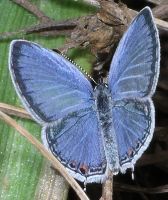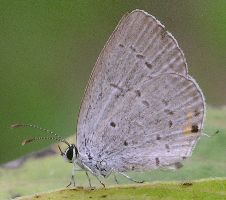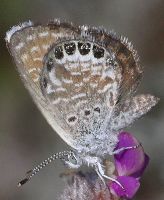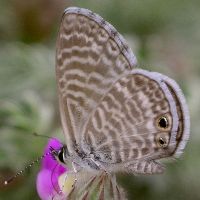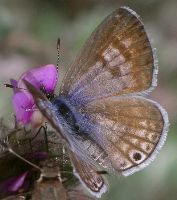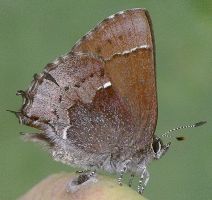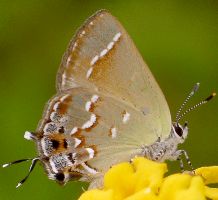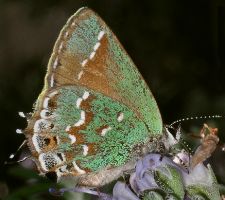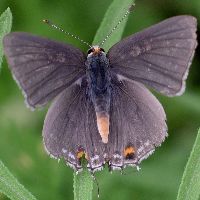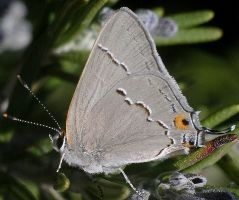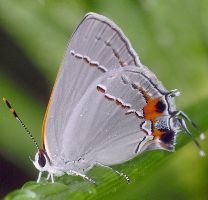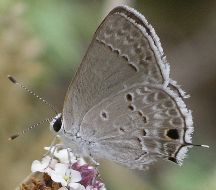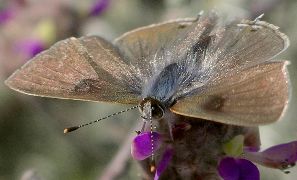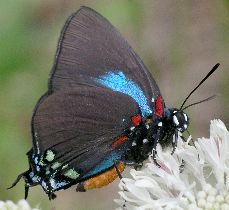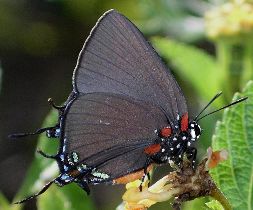
| Lycaenidae ~ Blues, Hairstreaks |
page 1 ![]() page 2
page 2
|
The Eastern Tailed-blue (Everes comyntas) has the most delicate and tiny of tails, but they often remain attached in spite of normal wear and tear on the wings. I've only seen this species occasionally compared to the two discussed in the preceding paragraphs. The undersides of the wings are quite light-colored with only very small dots, especially on worn individuals such as pictured here, while the top sides of the males' wings are brilliant blue.
Another infrequently seen species is the tiny Western Pygmy-blue (Brephidium exile). The row of eyespots on the rear underside of the hind wing is pretty distinctive, as is the small size.
One more blue that shows up once in awhile is the Marine Blue (Leptotes marina). The undersides of this species are covered with fine brown and tan stripes. The upper sides of the male's wings are brown with a strong lavender reflection, while the females have more complex markings, including blue towards the body. Henry's Elfin (Callophrys henrici) is a variable brown hairstreak that flies only in the spring. Like all hairstreaks, it almost never perches with wings open. The hind wing edges often look ragged because of the various stubby tails. The brown colors on the undersides of the wings may include thin white markings, as well as silvery frosting, usually with a metallic glint that changes with the light.
Although in the same genus as Henry's Elfin, there are striking differences between that butterfly and the Juniper Hairstreak (Callophrys gryneus). While Henry's Elfin has a limited season, the Juniper Hairstreak occurs for a much longer time each year. Both butterflies have an underlying copper brown color, but the Juniper Hairstreak has striking green as well. The colors of the Juniper Hairstreak are highly variable, especially as the green scaling tends to wear off. Even when fresh, some individuals have a drab and smooth olive color while others have a glittering array of bright green scales. On the most worn individuals, all traces of green disappear and the white marks remain on a brown background. The Juniper Hairstreak has the signature tails common to most members of this subfamily. These thin projections on the rear of the hind wing serve to look like antennae (many species have white tips on the tails to make them even more noticeable). Coupled with the eyespots, they serve admirably to draw attention to the back end of the butterfly, prompting predators to attack the less vulnerable parts. The hairstreaks have another trick they employ in this deception, which is to move their hind wings slowly up and down, in an alternating motion that causes the tails to hit each other and wiggle enticingly. And one more thing: the butterflies often try to turn themselves away from perceived danger (like a camera lens), so that the view of the wavy wing edges at the rear looks like a pair of big eyes on a thin body staring at the predator. In reality, the hairstreak is actually facing the other way, ready to escape! The whole display is quite interesting to watch. By far the most common hairstreak in our area is the Gray Hairstreak (Strymon melinus). I've seen so many of these that I even managed to get a shot of a male from above with its wings open (only the male has the orange abdomen). At times, this species can be as thick as bees at desirable flowers, with a half dozen or more feeding side by side. One of the largest of the drably colored hairstreaks, the Gray Hairstreak is usually very light gray on the undersides of the wings. The size of the eyespot and its surrounding orange can vary considerably. The front edges of the forewings are usually orange, but this is common on other species too.
The species most often confused with the Gray Hairstreak is the Oak Hairstreak (Satyrium favonius). This butterfly and its variations and subspecies have caused much confusion. It has sometimes been called the Northern Hairstreak to differentiate it from the Southern Hairstreak found mostly in Florida. In any case, it is not particularly common here, but does show up regularly. The general color of the undersides of the wings is more tan than that of the Gray Hairstreak, and the strongly zigzagged black and white line on the lower part of the hind wing is a good identification mark.
Another very common species that can be found much of the year is the Dusky-blue Groundstreak (Calycopis isobeon). The dusky blue color is found on the upper sides of the wings, but good luck seeing it. It can often only be glimpsed when the insect flies, and sometimes when it is moving its hind wings up and down a bit of the blue shows between the wings. In general, though, the best way to identify this lycaenid is by the prominent red line across the undersides of the wings. While it might seem strange to name a butterfly with a strong red streak "dusky-blue," there is a closely related species that already has the name "red-banded" to the east of us. It pretty much looks the same as the Dusky-blue Groundstreak except that the blue on the tops of the hind wings is not as pronounced. One butterfly almost never found far from its larval host plant is the Soapberry Hairstreak (Phaeostrymon alcestis). It happens that Western Soapberry (Sapindus saponaria) is a common plant here, so the butterflies can be found regularly even though they are never numerous. Although it looks much like the Oak Hairstreak, the Soapberry Hairstreak can be distinguished by the presence of a short white line in addition to the other longer lines on each wing's underside.
The Mallow Scrub-hairstreak (Strymon istapa) is seen in our area occasionally. Although it is in the same genus as the Gray Hairstreak, it more closely resembles a blue with tails. And, in fact, the tiny tails on this species are frequently broken off, which can add to the confusion. Unlike most hairstreaks, the undersides of the wings on the Mallow Scrub-hairstreak have more dots than bands. The upper sides of the wings (rarely seen) have prominent large black spots in the center of the forewings and smaller black spots at the rear of the hind wings. Males are more brown on top while females are a bit more blue.
Our most striking hairstreak, without a doubt, is the Great Purple Hairstreak (Atlides halesus). While it doesn't really have any purple on it, it does have a nice selection of other colors. The largest hairstreak in our area, it is another that rarely shows the splendid blue color on the tops of its wings. Instead, the undersides are most familiar, and they are mostly black. The males have turquoise shading on both the lower parts of the forewing and hind wing, which is lacking in females. Both genders have orange and blue bodies and red spots at the bases of the undersides of their wings. The larvae feed on mistletoe, but I've never found any. They must not be all that rare, as I see the adults regularly.
|
page 1 ![]() page 2
page 2
![]()
